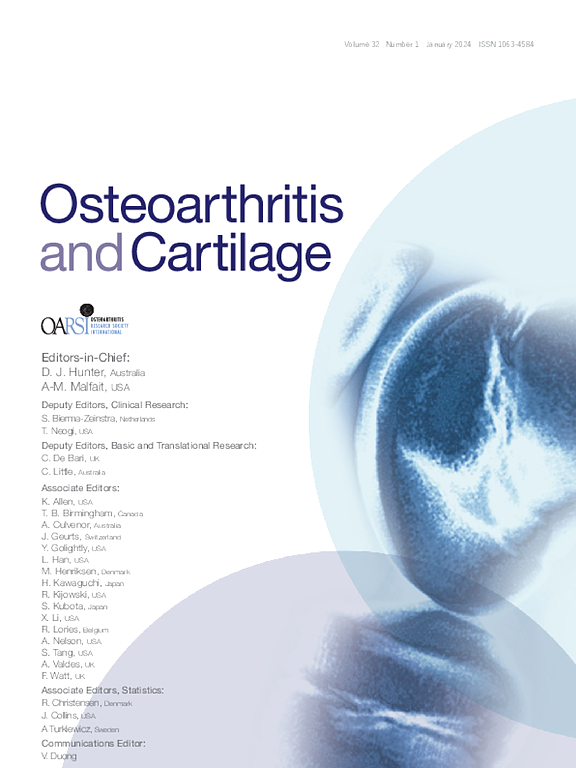Cartilage targeting cationic peptide carriers display deep cartilage penetration and retention in a rabbit model of post-traumatic osteoarthritis.
IF 7.2
2区 医学
Q1 ORTHOPEDICS
引用次数: 0
Abstract
OBJECTIVE Drug delivery to cartilage is limited by its complex architecture and avascularity. Cationic Peptide Carriers (CPC) have previously been optimized for improved cartilage transport and retention of drugs in vitro. In this study, we evaluated the kinetics, stability, and immunogenicity of CPCs after a single intra-articular injection using a rabbit knee injury model. DESIGN New Zealand White rabbits were administered a single dose of Cy5-labeled CPCs in knees receiving ACL Transection (ACLT) or Sham surgery. CPC biodistribution and retention within joint tissues and synovial fluid was evaluated 1 and 7 days after administration, and extra-articular kinetics were assessed in blood serum. Histology, immunohistochemistry, and RT-qPCR were performed on joint tissues to assess synovitis and protease activity. Proteolytic analysis of CPCs in the presence of arthritic enzymes was evaluated using synovial fluid size-exclusion filtration, FRET analysis, and computational molecular docking. RESULTS CPCs penetrated the full depth of GAG-rich tissues, notably cartilage, and were retained through the latest timepoint measured (one week) in both Sham and ACLT knees. Compared to ACLT knees, Sham knees had moderately higher joint retention at Day 1 (1.6-fold) and Day 7 (1.8-fold). CPC intra-tissue concentration strongly correlated with tissue GAG density, which did not considerably differ between surgical conditions at these timepoints. However, CPCs exhibited elevated vascular clearance and proteolytic fragmentation in inflammatory conditions. CPCs did not increase macrophage abundance, cytokine expression, or alter tissue morphology in ACLT knees compared to saline injections. CONCLUSION CPCs target the deep layers of cartilage, even in inflamed joints, and can be utilized to substantially improve the intra-joint bioavailability of therapeutics.求助全文
约1分钟内获得全文
求助全文
来源期刊

Osteoarthritis and Cartilage
医学-风湿病学
CiteScore
11.70
自引率
7.10%
发文量
802
审稿时长
52 days
期刊介绍:
Osteoarthritis and Cartilage is the official journal of the Osteoarthritis Research Society International.
It is an international, multidisciplinary journal that disseminates information for the many kinds of specialists and practitioners concerned with osteoarthritis.
 求助内容:
求助内容: 应助结果提醒方式:
应助结果提醒方式:


